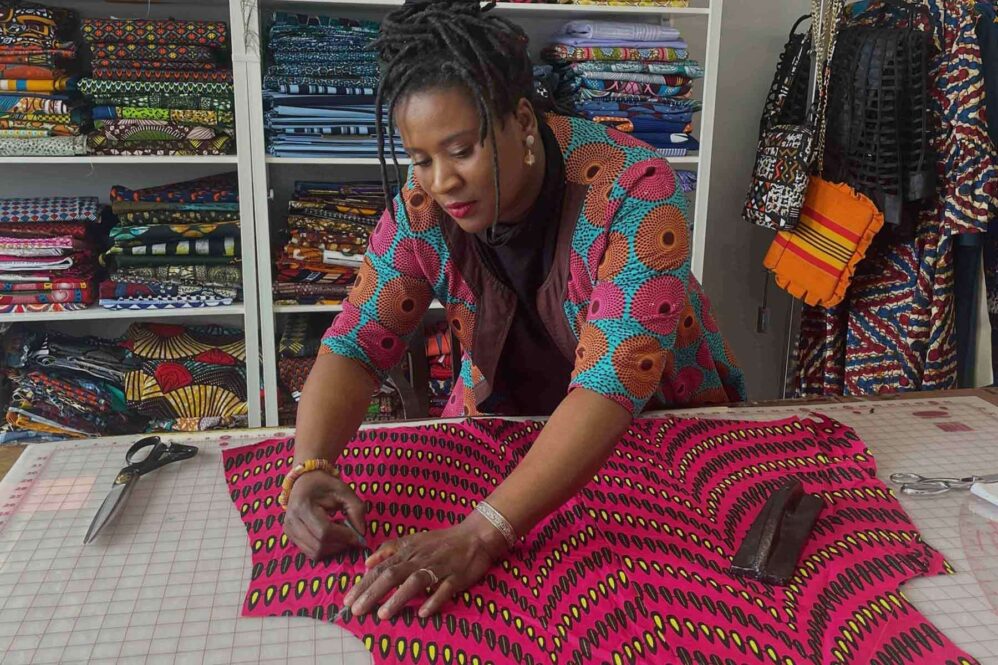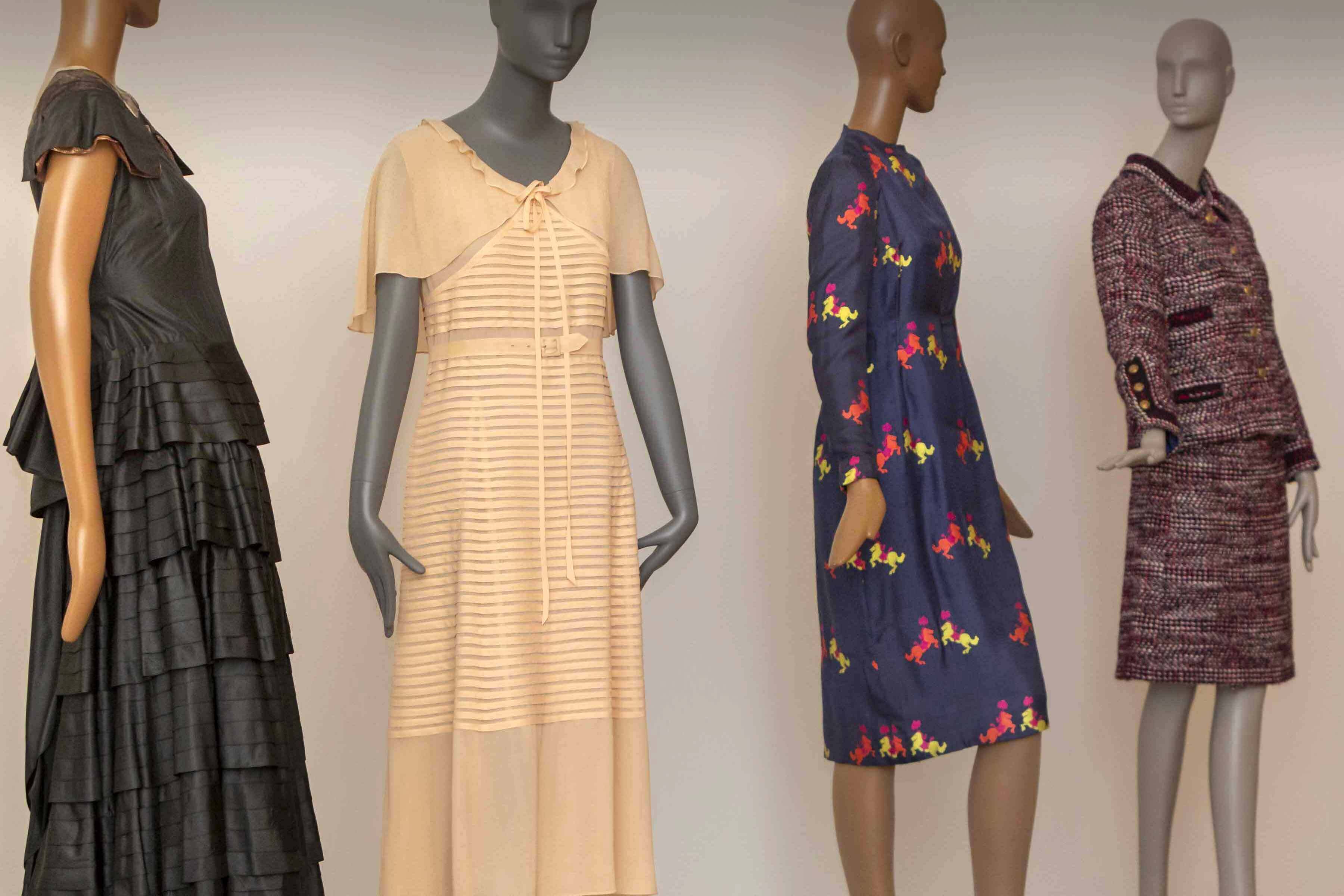Born into slavery in 1818, Elizabeth Keckley first learned how to sew from her mother.
Despite enduring decades of harsh treatment, her reputation as a high-quality dressmaker rose, and she was able to purchase her freedom in 1855. Keckley soon opened a dressmaking business in Washington, D.C., and rose through the ranks to become a leading designer for the social elite.

Keckley’s remarkable story, along with those of over 70 others, are told in Made It: The Women Who Revolutionized Fashion, opening November 21. The exhibition covers 250 years of fashion through the eyes of women, some famous, some not so famous, whose experiences intersect with the history of women’s ongoing struggle for equality.
“This exhibition provides us with the opportunity to reveal, recognize and celebrate the accomplishments of women designers, individually and collectively,” says Petra Slinkard, PEM’s Director of Curatorial Affairs and The Nancy B. Putnam Curator of Fashion and Textiles. “We hope to bring attention to their names and stories, many of which people have not necessarily heard before, and expand our understanding of the lasting impact these individuals made.”
2020 marks the 100th anniversary of the ratification of the 19th Amendment of the U.S. Constitution. The landmark legislation granted some women the right to vote and the historic milestone provides an occasion to think about the ways in which women — including women in fashion — have pursued equity and greater opportunity.
Zandra Rhodes, evening ensemble from The Conceptual Chic Collection, 1977. Kunstmuseum Den Haag. 0242227

Zandra Rhodes, evening ensemble from The Conceptual Chic Collection, 1977. Kunstmuseum Den Haag. 0242227
Organized in collaboration with Kunstmuseum Den Haag in the Netherlands, the exhibition incorporates 25 ensembles from PEM’s renowned fashion collection, including Claire McCardell’s 20th-century designer sportswear and pieces from the retail empire of L.P. Hollander, founded by a pioneering Boston businesswoman in the 19th century. Designers featured include Valentina, Gabrielle ‘Coco’ Chanel, Phoebe Philo, Vivienne Westwood, Donna Karan and Tracy Reese, among many others.
“Fashion can easily be written off as frivolous and expendable, but the truth of the matter is that it represents so much more than just a commodity. It represents a moment in time, movements within society and rich forms of personal and creative expression,” says Slinkard.
Chanel’s tweed suit and Diane von Furstenberg’s iconic wrap dress are ubiquitous fashion symbols in our world today, but they weren't always. Women were forging ahead in business and challenging the systems in place — demanding and expecting more. “Those demands in turn come to define pivotal shifts within our social history,” says Slinkard. Take the newfound independence of the bobbed hair and bold lipped 1920s woman who gained the right to vote at the turn of that decade, or the moment when supermodel Twiggy helped to make Mary Quant’s miniskirts popular in the 1960s.

Diane von Furstenberg, wrap dress, 1975, Adnan Ege Kutay Collection.
These significant shifts in silhouette are often tied to women’s lifestyles during a specific time. One such example is the exploration of women’s choices in swimwear. Classic 1940s and 1950s bathing suits are juxtaposed with contemporary pieces from Becca McCharen-Tran’s sportswear line Chromat. A champion of gender fluidity and body acceptance, the designer has said: “It’s time to explode our historically narrow view of beauty.”
Diane von Furstenberg, wrap dress, 1975, Adnan Ege Kutay Collection.
Many of these early women changed the landscape of fashion in radically different directions, but their achievements and accomplishments have been overlooked, says Paula Richter, PEM Curator for Exhibitions and Research. “The personal stories of these women are surprisingly modern,” she says. “Even some of the most historic designers are overcoming obstacles that still confront women today.”
Designer and Titanic survivor Lucy Duff Gordon became synonymous in the fashion sphere with her soft, frothy lace designs and was the first to introduce “mannequin parades,” precursors to today’s fashion runways. Names like Bonnie Cashin and Pauline Trigère emerged after World War II as top-tier designers of coordinated, easy-to-wear ensembles, further establishing the “American Look.” With a simplistic ease and practical bent, designer sportswear led clothing trends in a new direction.
Lucy Duff Gordon, dress, 1913–15, for Lucile Ltd.


Bonnie Cashin in tiger print B.tif. 2931965. Courtesy of the Bonnie Cashin Archive.
Although not a household name today, Bonnie Cashin was among the most groundbreaking American fashion designers of the 20th century. She became known for layered ensembles and loose-fitting outerwear such as coats, capes and ponchos, which were well suited for a more active lifestyle.
Bonnie Cashin in tiger print B.tif. 2931965. Courtesy of the Bonnie Cashin Archive.
Many of the choices available to women today, like separates, pant suits, pockets sewn into dresses, or a selection of plus-size clothing, result from the risks taken by these women and their drive to make items that they preferred to wear, as a woman. Take Madeleine Vionnet’s famously perfected bias cut, a method of cutting a textile diagonally across the grain. A simple shift in cutting fabric transformed the way clothing falls on our bodies today, revealing a more figure-hugging silhouette.
Visitors stepping through the doors of Made It will have no shortage of ensembles to feast their eyes on, but others will see how fashion through the ages has come to be instrumental in expressing political statements.
Tracy Reese’s new fashion line Hope for Flowers focuses on sustainability. And Carla Fernández’s garments asked the question: “Yes, I dream of a wider world, should I desire a narrower?” Color also represents a form of protest, like the early suffragettes leading marches in head-to-toe white ensembles. Or, more recently, when the women lawmakers of the Democratic party wore white to express solidarity at the 2020 State of the Union address, and again when Hollywood actresses stood strong by wearing all black to the 2018 Golden Globe Awards.
The fashion industry is constantly morphing and evolving and as it does so, we look to the experiences of women of fashion’s past and present to move us forward.

Fashion designer Carla Fernández and and her team advocate for socially conscious business practices and work to foster partnerships with people in Indigenous communities. As she has said: “We believe tradition is not static, and fashion is not ephemeral.”
For Slinkard, the exhibition is a celebration of these women’s vast contributions, and also an opportunity to say thank you. “In times of instability and challenge, these women stand to represent so many more women who persevered to enable us to live in this moment and occupy this space,” she says. “They recognized that fashion could serve as a catalyst for change.”
Fashion designer Carla Fernández and and her team advocate for socially conscious business practices and work to foster partnerships with people in Indigenous communities. As she has said: “We believe tradition is not static, and fashion is not ephemeral.”
Keep exploring
PEMcast
PEMcast 18: Alterations
14 min listen

Blog
A Studio Visit With Queen Adeline
6 Min read

Blog
Angels fly in to help digitize new fashion collection
8 min read

Blog
A Word with Gio Swaby
8 min read


